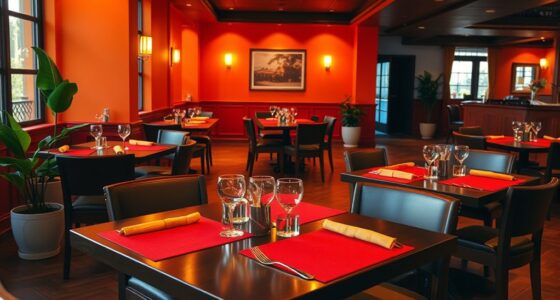To design an accessible host stand, guarantee the counter height ranges from 28-34 inches, with a section at 28 inches for wheelchair users. Use tactile markers, high-contrast signage, and clear visual cues to guide guests easily. Incorporate adjustable surfaces, flexible lighting, and wide pathways for comfort and safety. Choose durable, non-slip materials. By combining these elements, you’ll create an inclusive space that welcomes all guests — keep going to discover more ways to improve accessibility.
Key Takeaways
- Ensure the host stand counter height is between 28-34 inches with a designated lower section at 28 inches for wheelchair access.
- Incorporate adjustable surfaces, movable signage, and flexible lighting to accommodate diverse user needs.
- Use tactile markers, high-contrast colors, and visual cues for enhanced navigation and visibility for all guests.
- Maintain clear, obstacle-free pathways at least 36 inches wide to facilitate comfortable approach and movement.
- Position signage at accessible heights, including tactile and braille options, for clear, inclusive wayfinding.
Understanding Accessibility Standards for Host Stands

To guarantee host stands are accessible to everyone, it’s essential to understand the key accessibility standards that apply. These standards ensure that all guests, including those with disabilities, can comfortably use the space. The Americans with Disabilities Act (ADA) sets out specific guidelines for height, clearance, and reach ranges. For example, the counter height should be between 28 and 34 inches to accommodate wheelchair users. You also need to take into account clear floor space around the stand to allow easy maneuverability. Make sure the design doesn’t create obstacles or hazards. Using these standards as a foundation helps you create a host stand that’s welcoming, functional, and compliant. Staying informed about current regulations ensures you meet legal requirements and promote inclusivity.
Optimizing Height and Reach for All Guests

Achieving ideal height and reach in your host stand design ensures all guests can comfortably interact with the space. You should position the main contact surface between 28 and 34 inches high, accommodating most standing guests. For wheelchair users, include a section at about 28 inches, ensuring easy access without straining. The reach range for controls, menus, or reservation books should extend from 15 to 48 inches horizontally, allowing users to access everything without stretching or bending. Keep clear pathways, ideally at least 36 inches wide, so guests can approach comfortably. Consider adjustable features like height-raising platforms or movable components to accommodate different needs. By optimizing height and reach, you create an inclusive environment where all guests can engage effortlessly. Incorporating accessibility standards ensures your host stand is welcoming to everyone, including those with mobility challenges.
Incorporating Tactile and Visual Cues for Enhanced Navigation
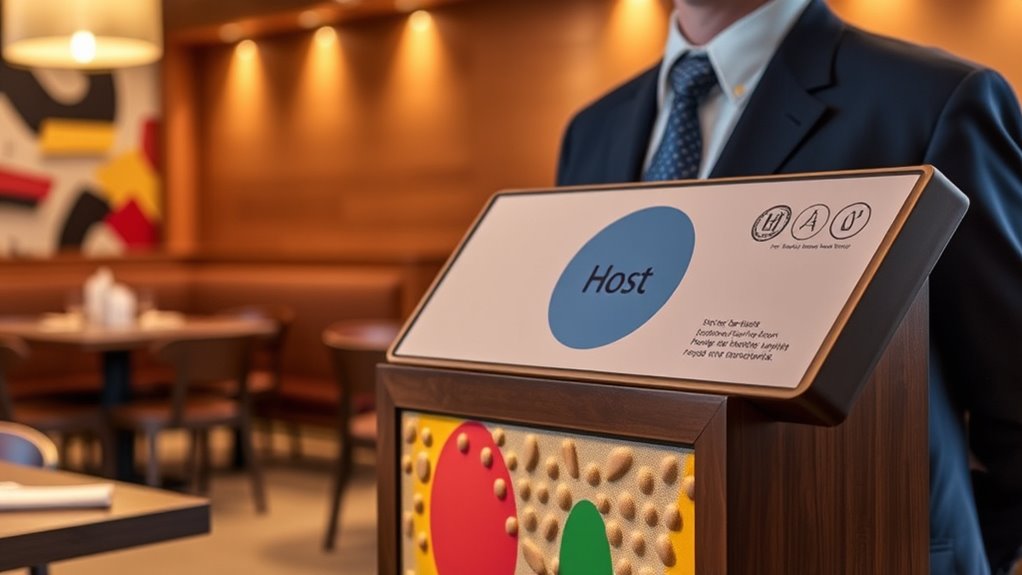
Incorporating tactile and visual cues into your host stand design helps all guests steer the space more confidently. You can add textured surfaces or raised symbols to key areas, such as check-in counters or directional signs, making them easily identifiable by touch. Use high-contrast colors for important signage and markings to aid guests with visual impairments. Clear visual indicators, like illuminated pathways or bold lettering, guide guests seamlessly through the environment. Keep cues consistent throughout the space to create a cohesive experience. Avoid clutter around tactile markers to ensure they are easily detectable. By thoughtfully integrating these cues, you create an inclusive environment where guests of all abilities feel more comfortable and independent when navigating your host stand. Regular assessment and organization strategies ensure that cues remain effective and clutter-free.
Utilizing Adjustable and Flexible Design Features
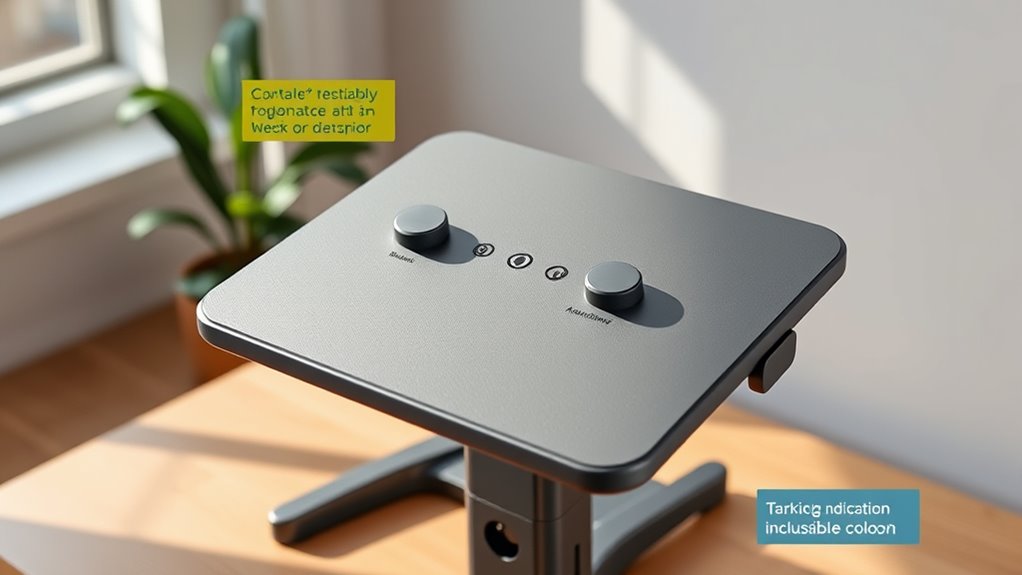
Flexible and adjustable design features are essential for creating a host stand that can accommodate a diverse range of guests and changing needs. By incorporating these elements, you guarantee everyone can access and use the space comfortably. Consider adjustable counter heights so staff can modify the setup for different users, or movable components that allow customization of the layout. Incorporate features like:
Flexible, adjustable features ensure your host stand welcomes everyone and adapts effortlessly to changing needs.
- Height-adjustable surfaces to suit various user preferences
- Movable signage or screens for clear communication
- Modular components that can be reconfigured quickly
- Stay informed about market trends and how they can influence your design decisions to ensure your host stand remains adaptable and current.
These adaptable features help you create an inclusive environment, promote efficiency, and respond to changing requirements effortlessly. By prioritizing flexibility, you make your host stand welcoming for all guests and staff, regardless of individual needs or circumstances.
Selecting Materials and Finishes for Durability and Safety
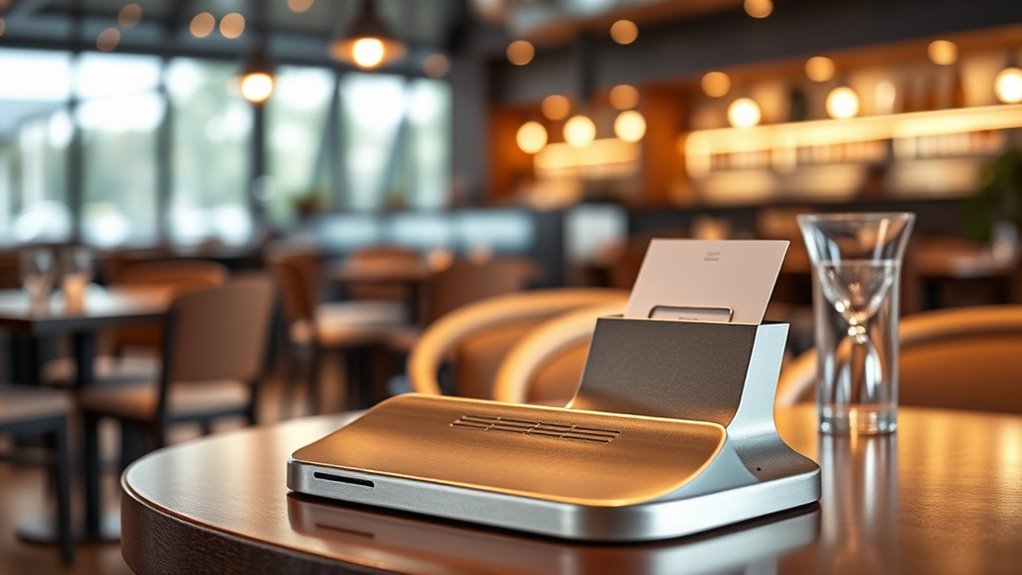
Selecting the right materials and finishes is essential to guarantee your host stand remains safe and durable over time. Opt for sturdy, impact-resistant surfaces like laminated wood or metal to withstand daily use. Avoid materials that chip or splinter easily, as they can pose safety hazards. Choose non-slip finishes on the top surface to prevent slips and falls, especially in busy environments. Consider finishes that are easy to clean and resistant to moisture, stains, and scratches, ensuring longevity and hygiene. Avoid overly glossy surfaces that can cause glare or reflections, impairing visibility. Prioritize materials that are smooth and seamless to reduce dirt buildup and make cleaning easier. Incorporating anti-slip coatings can further enhance safety by providing additional grip underfoot or on surfaces. By selecting appropriate materials and finishes, you enhance both safety and durability for your host stand.
Adding Inclusive Signage and Lighting Solutions
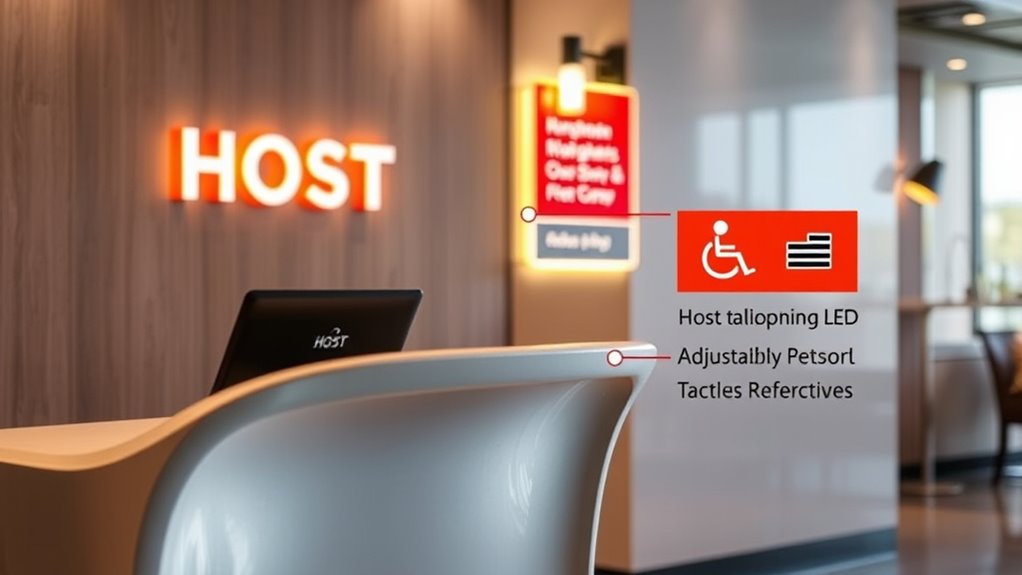
You can improve accessibility by choosing clear, visible signage that everyone can read easily. Adjusting lighting options guarantees the space is well-lit for all guests, regardless of their needs. Incorporating universal design principles helps create signage and lighting solutions that are functional and welcoming for everyone. Additionally, ensuring that signage is well-maintained and free of obstructions further enhances visibility and ease of understanding for all visitors.
Clear, Visible Signage
Clear and visible signage is essential for guaranteeing that all guests can easily locate the host stand. You want signs that catch the eye and convey information quickly. Use high-contrast colors and large fonts to improve readability from a distance. Position signs at eye level and ensure they’re unobstructed for everyone to see. Consider including:
- Clear, concise words like “Host Stand” or “Welcome”
- Symbols or icons for quick recognition
- Consistent placement throughout the venue
These elements help guests navigate effortlessly and reduce confusion. Avoid cluttered or overly decorative signage that can distract or confuse. Regularly check signs for visibility and clarity, updating them as needed. Well-designed signage not only guides but also enhances the welcoming atmosphere for all guests. Incorporating expert voice actors into signage design can also improve overall communication and engagement.
Adjustable Lighting Options
To guarantee all guests can easily find their way, incorporating adjustable lighting options alongside inclusive signage is essential. You should install lighting that allows for brightness adjustments, ensuring visibility in various lighting conditions. For instance, dimmable lights help create a welcoming atmosphere during evening hours, while brighter settings improve visibility for those with visual impairments. Consider installing task lighting directly over the host stand to illuminate your workspace clearly without causing glare. Motion sensors can automatically turn lights on when someone approaches, providing convenience and energy efficiency. Additionally, using contrasting light levels can help highlight signage and key areas. Incorporating unique and wicked planters into your decor can also draw attention to important signage and create a more inviting environment. By offering flexible lighting solutions, you ensure everyone, regardless of their visual needs, can navigate your space confidently and comfortably.
Universal Design Principles
Implementing universal design principles guarantees that signage and lighting are accessible to everyone, regardless of their abilities. You should prioritize clear, high-contrast signs with large, legible fonts to aid visibility. Additionally, incorporating adjustable lighting levels ensures comfort for all users, especially those with visual impairments. To create an inclusive environment, consider these key aspects:
- Use tactile and braille signage for easy identification
- Install lighting that minimizes glare and shadows
- Ensure signage is positioned at accessible heights and angles
- Incorporate accessible lighting options to accommodate diverse needs and preferences.
Frequently Asked Questions
How Can Technology Improve Accessibility at Host Stands?
Technology can greatly improve accessibility at host stands by incorporating features like adjustable-height counters, voice-activated systems, and visual display boards. These tools help accommodate guests with diverse needs, making check-in smoother and more inclusive. You can also use mobile apps for reservations or digital menus, reducing physical barriers and streamlining the experience. By embracing these tech solutions, you guarantee all guests feel comfortable and welcome from the moment they arrive.
What Are Cost-Effective Options for Retrofitting Existing Host Stands?
Ever wondered how you can make your host stand more accessible without breaking the bank? You can start with simple, cost-effective solutions like adding adjustable height platforms or portable ramps. Using tactile signage and high-contrast colors also helps. Why not repurpose existing materials or seek donations for assistive technology? These small upgrades can greatly improve accessibility, ensuring everyone feels welcome and comfortable at your venue.
How Do Cultural Differences Influence Accessible Design Preferences?
Cultural differences greatly influence accessible design preferences. You should consider local customs, language, and social norms, as these shape what users find comfortable and respectful. For example, some cultures prioritize privacy, affecting the height and layout of host stands, while others value openness and community. By understanding these preferences, you can create designs that are inclusive, welcoming, and functional across diverse cultural contexts, ensuring everyone feels comfortable and accommodated.
Are There Specific Regulations for Outdoor Versus Indoor Host Stands?
Did you know that regulations often differ considerably between outdoor and indoor spaces? For outdoor host stands, you must consider weather protection, durability, and visibility, which aren’t as critical indoors. You’re required to follow local safety codes that address outdoor hazards, like wind or rain, while indoor standards focus on accessibility and space efficiency. You need to guarantee your design meets all relevant regulations for both environments to keep everyone safe and comfortable.
How Can Staff Be Trained to Assist Guests With Diverse Needs Effectively?
You can train your staff by providing extensive disability awareness education, focusing on diverse guest needs. Encourage active listening and patience, so they better understand individual requirements. Use role-playing scenarios to practice assistance techniques, and regularly update training to include new accessibility practices. Empower staff to ask guests how they can help, ensuring respectful, personalized service that makes every guest feel welcomed and accommodated.
Conclusion
By designing accessible host stands, you guarantee everyone feels welcome—no matter their abilities. Keep standards in mind, optimize height, add tactile cues, and choose durable materials. Incorporate adjustable features and clear signage to guide all guests smoothly. Remember, a well-designed host stand is like a trusty steed—reliable and inclusive, making every guest’s experience as seamless as a well-tuned clock. Prioritize accessibility today, and you’ll truly serve everyone with grace and ease.


